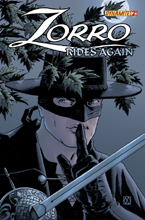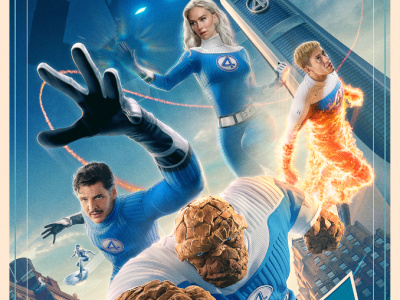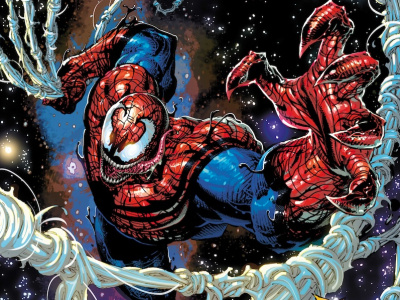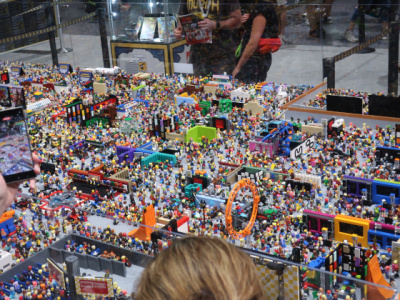
Recently ICv2 caught up with multiple Eisner Award-winning writer Matt Wagner, who graciously consented to talk about his run on Dynamite Entertainment’s Zorro. The first issue of the concluding chapter of Wagner’s Zorro saga, Zorro Rides Again, ships in July. Without giving away any crucial narrative details of the new series, Wagner talks at length about returning this archetypal American character to his pulp fiction roots, how he made use of Isabel Allende’s fictional Zorro biography, and Zorro’s enormous influence on American pop culture.
What was it about the character of Zorro that most interested you?
He’s the absolute prototype for the modern American super-hero! Zorro first appeared in the pulp magazine, All-Story weekly in 1919! And his character established all the tropes that have since become staples of what this distinctly American myth entails; the caped and masked crusader for justice, the mysterious name and snazzy black duds, the secret hideout and feigned identity as a bored aristocrat—he even has a bitchin’ ride that puts all the others to shame! I mean Zorro’s most obvious descendent is Batman but his influence is also evident on The Shadow, The Lone Ranger, The Green Hornet and many other such adventure narratives. Obviously, I just love this sort of character—the masked avenger of the night—and to have the chance to redefine the original avatar of this sort of archetype is a very attractive prospect.
Who are you writing Zorro for? Can you update the character without upsetting the fans?
Oh, sure. Any character that has had this sort of longevity is basically reinterpreted by each new generation of creator. The very first Zorro of the silver screen, Douglas Fairbanks…his version of the character was a tad removed from the original pulp version and so too were each subsequent incarnation in every other medium. The key is to always remain true to the roots, ideals and larger characteristics of Zorro and what he represents. Thus, my version of this hero has a slightly more modern spin on his adventures, but it’s still totally "Zorro" through and through.
There have been several previous comic book and comic strip versions of Zorro, which do you like the best?
I love the Alex Toth work, of course, but the work that Don McGregor and Tom Yeates did was also marvelous.
One of our goals was to try and return the character to its pulp roots. He’s less of the swashbuckling "gay caballero" and more of a mysterious rogue who strikes terror into the hearts of his enemies. On a very basic level, you can see that in the fact that’s wearing al black, which of course means he’s operating at nighttime. In a lot of the movie versions, you see Zorro dashing through the center of town in the middle of the day and my thought was, "Why would he be wearing black in the hot California sun?" Certainly, we still have Zorro’s easy swagger and mocking attitude towards his foes—this isn’t "Dark Zorro"—but we really wanted to try and show what a serious crusade he’s undertaken. This is one guy against the assemble military might of an entire corrupt regime and, in keeping with that, our bad guys are reeeally bad and brutal. In the old Disney series, one of Zorro’s main foils was the fat and bumbling Sgt. Garcia. Well, in the original novel—the title of which was The Curse of Capistrano—that character is quite different; he’s a big brute named Sgt. Gonzales. That’s how we’ve treated him as well. Again, returning the narrative to its pulp roots and stressing the cost and danger of our hero’s adventures.
How is Zorro relevant in the 21st Century?
Oh, c’mon…when is a hero fighting against injustice and oppression ever not relevant? Especially in the troubled world of today! In these sort of uncertain times, a hero who stands up to the corrupt forces of power and fights for the rights of the underdog seems be a natural prescription for what ails us!
How much research have you done into the Alta California period? Do you have a specific decade or two in mind for your stories? What portion of the 1769-1850 era have you singled out for your stories?
I’ve done a fair amount of research and the dates I have in mind for our narrative are around 1810-1815 or so.
Were your first Zorro comics based on Isabel Allende’s fictional biography of the character? If so, how did her approach differ from others, and how did it affect your perception of the character?
Yes, I was able to utilize and cherry-pick what I liked about the Allende novel while still making it our own version of the character. One of the most obvious differences in approach is the fact that, in the Allende novel, Zorro doesn’t appear in costume until the final 30-40 pages of the book. Obviously, that wouldn’t work for the comic book version and so I structured to the first story arc to alternate between two different narrative time frames—flashbacks to Diego de la Vega’s childhood and his development as the character we all know and love, alternated with Zorro’s first, very mysterious strikes against the ruling hierarchy. In fact, what I’ve tried to do with this series is distill all the many different former versions of Zorro into our own particular blend. One of the things I really loved about the Allende version was the fact that she made him a mestizo—of mixed race—his father being a Spanish caballero and his mother, a local native. This gives a very poignant resonance to his empathy for the plight of the oppressed and, in fact, adds a certain spirituality to the character. One of my favorite scenes from the book (which we included in our version) is when Diego and his milk-brother, Bernardo, go on their Spirit Quest at the age of thirteen. Bernardo’s spirit guide comes to him in the form of the wild colt that will eventually become Zorro’s mighty steed, Tornado. Diego’s spirit guide comes to him in the form of a fox ("Zorro" is Spanish for fox), leading his shaman grandmother to declare that he will one day exhibit the fox’s cleverness and skill; "YOUR MOTHER IS THE MOON AND YOUR HOME IS THE CAVE. YOU WILL DISGUISE YOURSELF AS YOU HIDE IN THE DAY AND ACT IN THE NIGHT."
How have you attempted to expand the Zorro mythos in your original story arcs for the character?
Our first three story arcs were very much establishing Zorro and his world. The third one—"Fox Tales"—was an attempt to show how the rest of Zorro’s world perceives both him and his actions, from a variety of viewpoints. These next two storylines have some significant changes and dire consequences for Zorro as a character. We introducing some new challenges that will cause Zorro to question not only the cost of his crusade but indeed what sort of a man he really is.
Do you see Zorro as more of a "masked vigilante" saga or as a western comic? How does it differ from the standard sort of western?
Well, the neat thing about Zorro as a narrative is that it’s both a masked vigilante saga and a western comic! The biggest difference between this and what we think of as a standard western is the slightly different time frame and the differences technology. In that respect, Zorro’s stories bear a closer resemblance to the colonial era—there are no trains, no revolvers, all guns are single-shot muskets and there is no dynamite as of yet. But the masked avenger aspect really works in any time period! Another big difference is the aspect of his crusade itself—he’s not just going up against some "bad guys", he’s trying to change the entire structure of a corrupted society. Zorro isn’t out for some kind of personal revenge; his goal is far loftier than that. After all, his rallying cry is, "JUSTICE! JUSTICE FOR ALL








